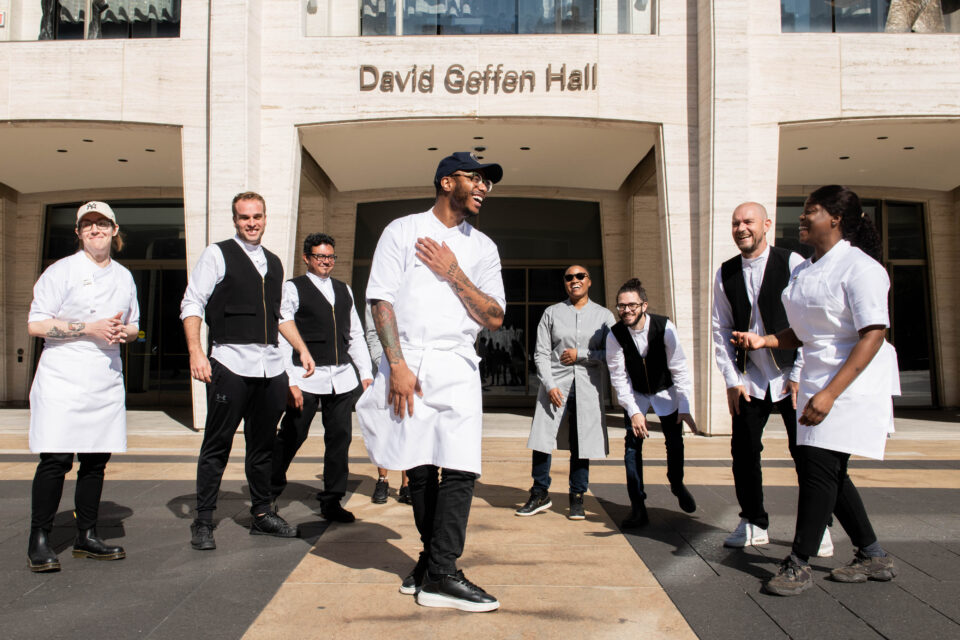Pop Stuff: In NYC, Shaping A New True North of Dining Out
Perhaps what we need is to normalize a breakfast of tamagoyaki, a soup-dumpling lunch, chicken stew and fufu after a long day, and a midnight samosa snack
When I moved to New York in 1998, for some it was still a minor rite of passage to make it past the velvet rope at the Royalton Hotel, down the signature royal blue carpet, and sink into a white chrome-legged chair in the already sunken Philippe Starck-designed lobby bar, all so a blasé server might deign to take an order. The bar and adjacent New American restaurant, once crowned Club Condé because of the frequency of Condé Nast masthead power lunches held there, were symbolic of a major shift in hotel trends, something of a signifier of the city’s pulse. Ian Schrager, the man synonymous with the cool-ification of hotels, launched the refurbished Royalton in 1988 (it was built as an apartment hotel ninety years prior), on the heels of the success he and his partner Steve Rubell had experienced with the launch of Morgan’s Hotel in 1984. Morgan’s, which birthed the moniker ‘boutique hotel’, was also home to Jeffrey Chodorow’s Asia de Cuba, a restaurant as famous for having doormen with headsets as it was for blending Chinese and Cuban cuisine, a novelty in the beige landscape of hotel dining. All of it had heralded a sea change in hotels and their restaurants.
That it was Schrager who established a new vanguard of hotel-as-destination by transforming the staid gilt-edged lobby into a starry scene and expanding the food horizons of hotel menus, is unsurprising. Schrager and Rubell’s hotels were a next act to their iconic Studio 54, a nightclub that was equally cultural phenomenon, playing second home to Andy Warhol’s Factory and capturing the cachet and hedonism of the ‘70s disco era. Little had transformed the hotel landscape since a first wave of glamorous hotels in New York at the turn of the previous century. These Gilded Age buildings that counted the Waldorf Astoria, The Plaza and the Astor amongst their ranks were plush stages for New Yorkers to bask in wealth amassed during the industrial revolution. When a more contemporary New York cried for a different energy, Schrager met it by pushing back on the pretensions of the grand hotels whose calendars were dotted with white-glove weddings and blue-blood debutante balls.
The move from old-world capitalists to new-age cool kids that Schrager ushered in seems to be giving way to another transformation in hotels, one that I am truly excited about. As the city comes back to life, under the post-pandemic gaze of a value shift, many luxe hotels are revitalizing themselves through a culinary evolution that prioritizes a diverse range of food cultures over the Eurocentric menus that are mainstays of luxury hotel restaurants. In doing so, and in putting the heft of money, real estate, marketing and a built-in clientele behind their chefs, newer hotel projects are elevating cuisines that comprise a sliver of dining-out bucks in New York or are the domain of smaller cucinas, when they have visibility at all. In turn, talented chefs with regional knowledge and a desire to revel in a heritage and reveal foodways, are making these hotels culinary destinations for locals and tourists alike.

Photo: Courtesy of Popular
Schrager, who championed Asia de Cuba decades prior, seems to have been intentional about this shift in 2021 when he reopened the PUBLIC – his Lower East Side property. In 2017 the PUBLIC had debuted a tie-up with famed French chef Jean-Georges Vongerichten, along with a smorgasbord-like menu. When the PUBLIC re-opened post-covid, the team had thoughtfully reinvented its kitchen via Peru. The hotel’s new restaurant, Popular, brings together Peruvian chef Diego Muñoz, whose Astrid Y Gastón in Lima is on The World’s 50 Best Restaurants list, with Michelin-starred local John Fraser. In reflecting the waves of global immigration to Peru – Incan, Spanish, Moorish, African, Italian, Chinese and Japanese, Popular echoes an adventurous palate that I hope is becoming a hallmark of contemporary hotel stays. The opening, orchestrated by longtime Schrager collaborator and hospitality maven Ben Pundole (also the founder of award-winning future forward travel site AHotelLife.com) called to the PUBLIC’s brand as playful luxury, debuting a spot filled with blond wood and foliage and nodding to the emphasis on the warmer climes of the Global South.
Multi-stranded influences at Popular deliver a truly flavourful Peruvian menu. Divided into vegetables, wok and wood-fired, dishes are so delectably paired with dressings that they convey the slight sensuality of a slip dress. Fried oyster mushrooms with ahi panca yogurt and cilantro are a delicate dance of umami and tart. The indulgent creaminess of roasted sweet potato is balanced with the crunch of toasted hazelnuts. In the wok section, sticky prawns chow mein are noteworthy for a teasing blend of chew and tang. Of the wood-fired mains, octopus with potato cream and duck with lima bean cream stand out for using pureed vegetables to impart depth and decadence, while drawing brightness from a simple spice rub or ceviche sauce. The stars of the menu are the ceviches themselves, also available at the adjacent Cantina and Pisco Bar. Variations include a sparkling salmon tiradito and a creative roasted celeriac with hibiscus and coconut. The Pisco Bar, home to Popular’s cocktail program, highlights the namesake South American brandy and opens up a new world of libations.
The trend towards restaurant openings in New York that eschew New American, French or Italian menus for cuisines that have infrequently occupied prime boutique hotel real estate includes: more Latin-American fare at the Freehand Hotel’s Comodo in Gramercy, a Japanese grill at Vestry in the Dominick Hotel in Tribeca, and Israeli flavours on offer at the Hoxton in Williamsburg, all well worth a stay on a travel itinerary, or at minimum, a dinner reservation.
Comodo opened in late 2021 after new owners at the Freehand Hotel partnered with Tamy Rofe and Felipe Donnelly, whose 2012 Soho restaurant is Comodo’s namesake. The Freehand, occupying a historic 1928 building that was once the George Washington Hotel, at a busy intersection on 23rd and Lexington, is an unexpected reprieve from teeming Manhattan streets and ideal for a city stay that calls for being both in the mix and at a snug remove. Tucked inside a corner of the building, the restaurant’s Latin American influences are right at home amongst the warmth of stained-glass panels, cherry wood beams, a sumptuous bar and soothing lighting.
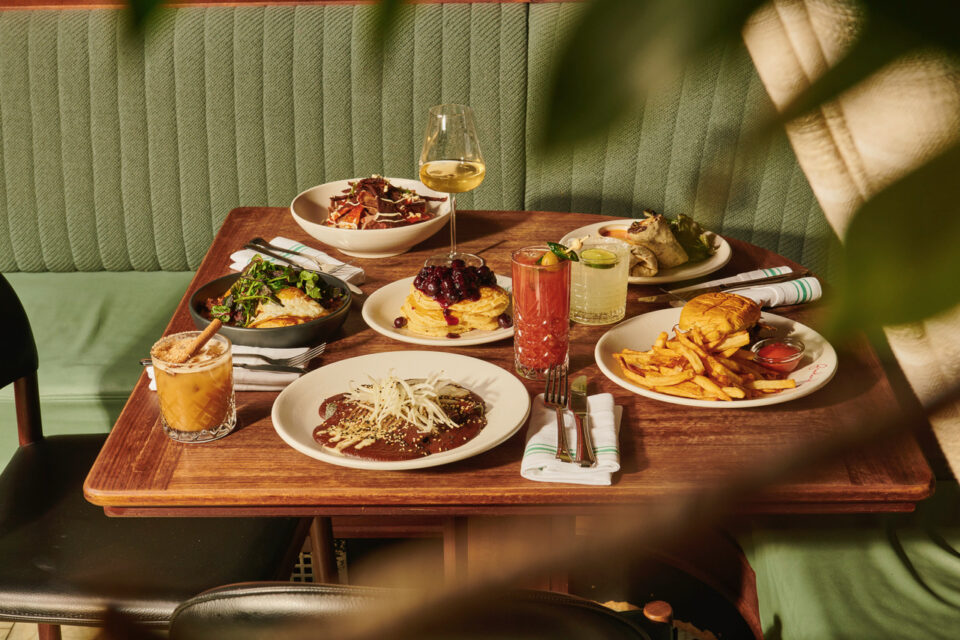
Photo: Louise Palmer
This new Comodo feels more ambitious and experimental than the original. The menu draws from Mexico, Brazil, Columbia and Peru, without ever feeling cobbled together. Too much of the excellent pao de quijeo – a Brazilian cheese-filled bread – is only a bad idea if it leaves you with no room for smoky wild mushroom tacos dusted with habanero ash or their coffee-rubbed pork counterparts. My favourite amongst the small plates was a rich mole paired with baby eggplant and expertly undercut with feta. The large plates have something for all moods; for comfort, the achiote chicken on verdant green rice and for decadence, the tilefish with a buttery squid ink risotto and balancing lime zest. Sweets are a must here. The churros donuts with Mexican chocolate sauce and the coconut yucca cake are unfussy yet transporting indulgences. Try both and dance off dessert at the hotel’s Georgia Room, or wind down with a mezcal-infused cocktail at Bar Calico upstairs.
For a swankier evening or special occasion, Vestry, classically-trained chef Shaun Hergatt’s take on Japanese inflected cuisine, is a dream in impossibly high-ceilinged digs and a differentiating take on Japan’s food culture, given the recent growth in sushi and omakase menus in New York. Situated where Soho flirts with Tribeca, in the David Rockwell designed Dominick Hotel, Vestry opened in late 2020 and quickly garnered a Michelin star. The food is too pretty to eat and too delicious to resist. In the raw section, beets with preserved tomatoes and feta, and chutoro with yuzu, wasabi and radish taste just-plucked from land and sea. The menu changes frequently and a delicious corn risotto has been replaced by one of saffron, tomato confit and pine nuts, that I am sure is equally refreshing. Creativity and frame-worthy presentation aside, Vestry’s strength lies is in letting superior ingredients do the work and to this end their Binchõ-tan (Japanese white charcoal) grill reigns supreme over the menu with a seafood focus that gives salmon a cracker-crisp skin and cooks scallops to smoky perfection.

Photo: Courtesy of Vestry
Across the river in Williamsburg, Israeli food at the Hoxton is one of many reasons Brooklynites could cite for claiming the better borough. Indian-born, UK based entrepreneur Sharan Pasricha’s Hoxton hotel landed here with a splash in 2018, the first U.S. location of the rapidly expanding East London brand. Williamsburg has been post-industrial ever since a landscape of slick residential buildings and artisanal grocers replaced its warehouses but, to their credit, design team Perkins Eastman maintained elements of the Rosenbach Water Tower Factory that formerly occupied the Hoxton site. The hotel’s heart is an old brick carriage house, punctured with arches, which makes a focal point for a sprawling lobby that houses a bar, coffee bar and restaurant. Surrounding it, an impressive staircase and high black steel beams contrast with parquet flooring and scattered furniture to convey a feeling of industrial chic that risks an eye-roll inducing ubiquity in Williamsburg, but feels organic and even cheeky at the Hoxton.
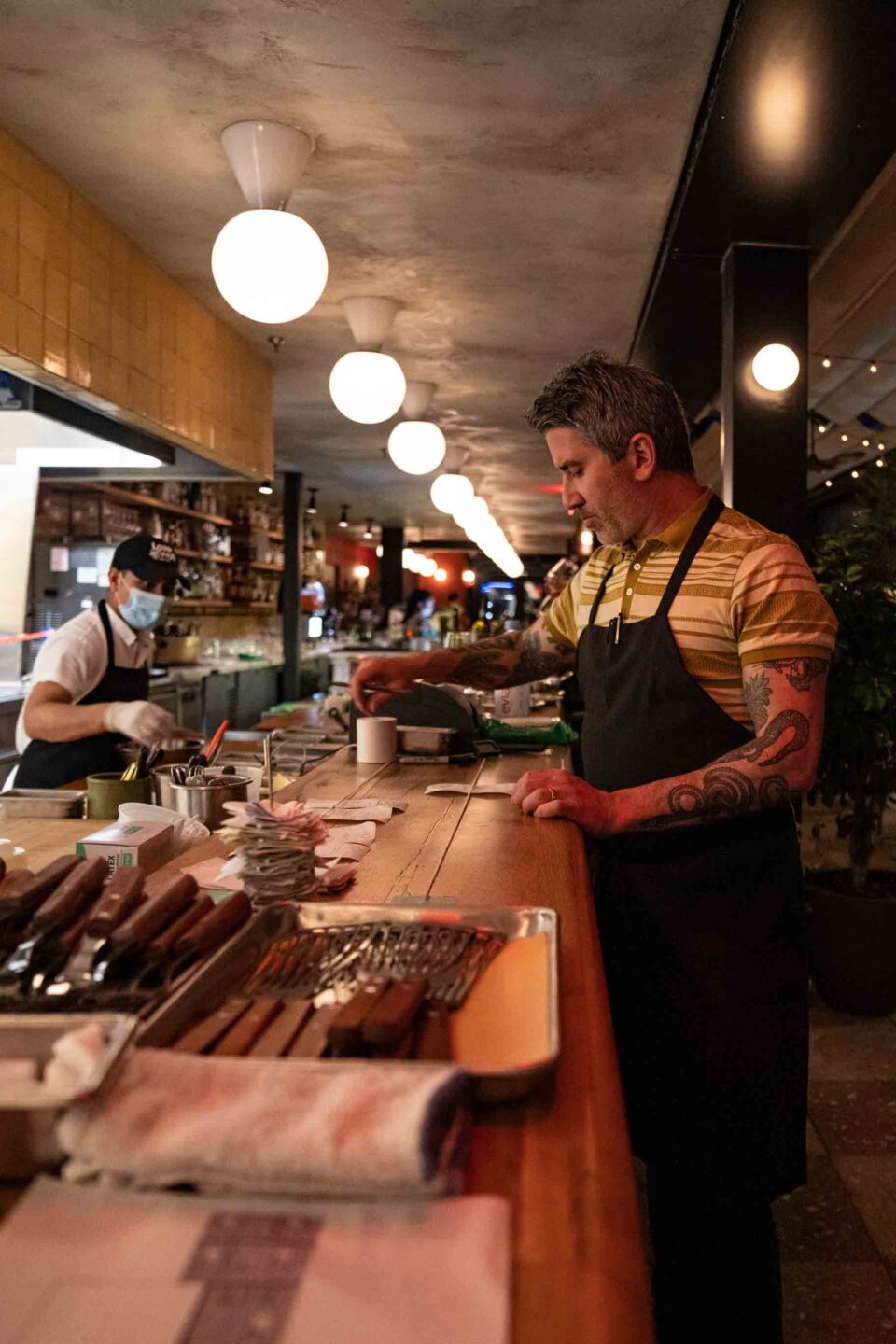
Photo: Colby Kingston
The hotel capitalizes on its space to show off its two restaurants, Laser Wolf on the rooftop and K’Far in the lobby, both inspired by Israeli chef and James Beard honoree Michael Solomonov. Reaping the benefits of a waterfront Williamsburg location, Laser Wolf (named for one of Solomonov’s many spots in his hometown Philadelphia) boasts unobstructed, panoramic views of the Manhattan skyline. Nothing goes better with a crisp autumn chill or the onset of summer than kebabs over live coals and Laser Wolf delivers. Whilst the skewered meats are exceptional, the spiced whole trout and the eggplant halves with sour cherry and walnuts are standouts in their own right. A sunset meal is incomplete without the endless supply of salatim – vegan mezze that come as a first course and which you’ll want to keep on hand. This is not your standard mezze; the fennel-spiced oranges and the pineapple with celery are stiff competition for babaganoush and hummus classics. The salatim arrive in eleven round tins on a platter reminiscent of a Gujrati thali, and celebrate food sharing in a way that will truly scratch a covid-induced itch for togetherness. The single dessert on the Laser Wolf menu – a brown-sugar soft serve with a strong dose of sesame, is halva’s delicious iced cousin.
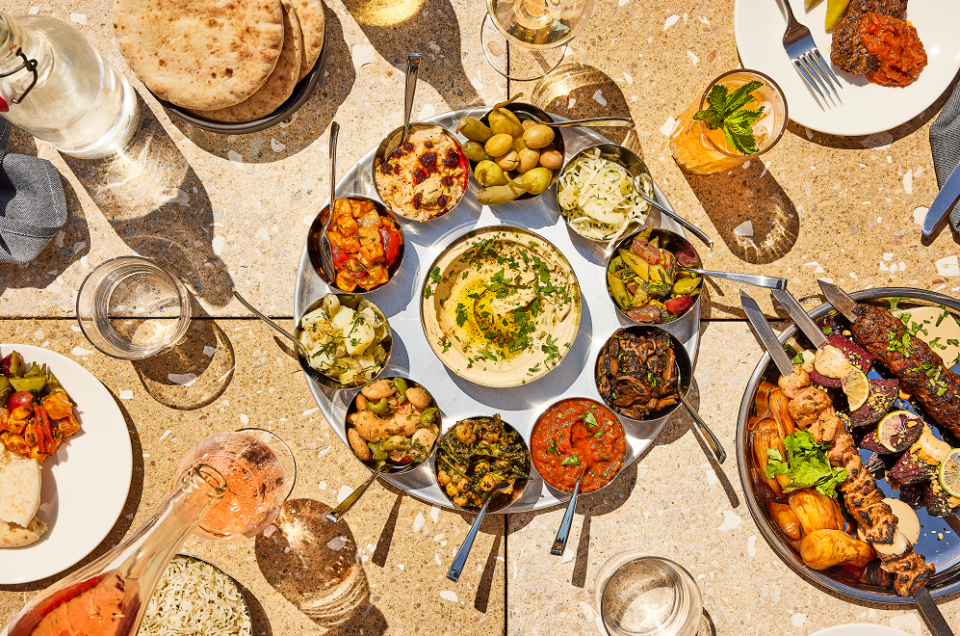
Photo: Michael Perisco
Downstairs, K’far is an all-day café and bar with a full dinner service that feels cozy in winter and connects to a leafy atrium for prime summer seating. Divided into small and large plates, the menu works equally well for individual portions, in contrast to the designed-for-sharing menu at Laser Wolf. Challah rolls with labneh butter are a guilty pleasure that I was intrigued to see could be made even more decadent with the addition of caviar. A combination of small plates can come together for a gorgeously varied meal and amongst them the Palestinian lamb tartare and fennel caesar make for exquisitely layered spice and texture. Amongst the large plates the cod chraime and the za’atar brick chicken with green tahina offer an appealing combination of comfort food with complex flavour.
The flurry of hotel restaurant launches meeting post-pandemic demand for travel and leisure have not all turned to the South or East for food inspiration, yet even amongst the ones that have stuck with Eurocentric cuisine, I’ve noticed an inclination lean into foodways that are under-explored. This was particularly apparent in two of the most highly touted openings of 2022; Koloman – the Austrian-inspired restaurant that replaced chef April Bloomfield’s gastropub The Breslin in the Ace Hotel, and the Hotel Chelsea’s revamped El Quijote restaurant, which maintained the original eatery’s Basque Country spirit along with it 1930s roots and name.
When the Ace Hotel arrived in Manhattan in 2009, occupying the 1904 landmark Hotel Breslin, it became something of a magnet for a neighborhood that had seen its heyday in the swinging ‘20s. The area, earlier known as Tin Pan Alley – a locus of popular culture once thronging with musicians, had ceded its place to a growing and spreading New York. The Ace established a footprint for what became an explosion of hotels and restaurants in the revitalized district, now known as Nomad. Meanwhile, a little further south, the iconic Hotel Chelsea, an enduring New York landmark and onetime home to a name-check of greats – Leonard Cohen, Patti Smith, Bob Dylan, Arthur Miller and more – survived to tell the tale of a careful restoration, bones intact, under the auspices of Sean MacPherson and his partners, hoteliers behind The Bowery, The Jane Hotel and others. By reimagining iconic spaces in novel ways, these projects made new waves in New York’s boutique hotel landscape after Schrager’s eighties and nineties push against the past. Now, their newly opened flagship restaurants speak to a continued evolution that brings focus to more varied cuisines.
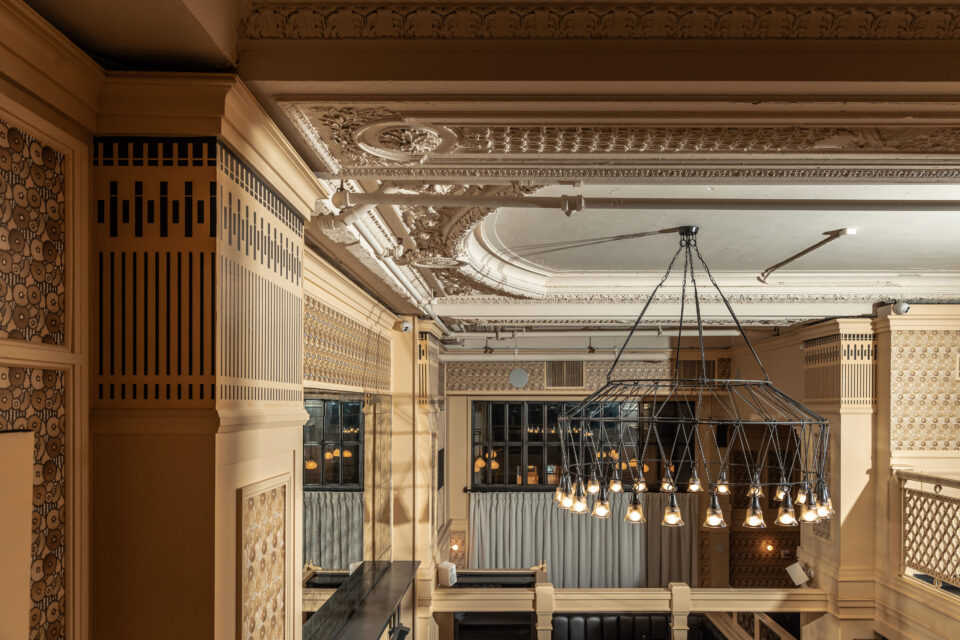
Photo: Courtesy of Koloman
Koloman replaces The Breslin’s sultry British barroom energy, once infused with the aroma of nose-to-tail pig creations, with a breezy Viennese makeover. The former den-like space at the Ace boasts eggshell white walls, ceilings and moldings. The creamy expanse is spliced only with fine black lines etched on wall paper, or forming the backs of chairs, elegant light fixtures and the hands of an otherwise transparent clock floating behind a bar that is chicer than its patrons. Koloman is named for Austrian artist Koloman Moser, part of the Viennese Secession movement, founded in the late 19th century, on the premise that art should expand out of the frame to include furniture, textiles and design. Indeed, there is something hypnotic in a space in which the oval molding, speaks to the circular light fixture, which riffs off geometric wall prints, whose shapes coalesce on an elliptical dinner plate, on which a perfectly rectangular salmon en croûte sits halved in ying-yang harmony. Space that makes you want to linger and food that insists on being savoured are the rare combination that Koloman has struck like the arms of its bar-clock folding over each other.
The restaurant comes via EHV (from Rohit Khattar and Rishiv Khattar), the hospitality company behind the top-ranked Indian Accent, Comorin and Hosa, and is designed by London based Russell Sage Studio. Chef-partner Markus Glocker, of the award-winning Bâtard, exhibits the classical training he received in London, Munich and Berlin and the food sensibility of growing up working in his family’s Vienna hotel. Glocker showcases Austrian cuisine, often overshadowed by its neighbours, so that it glimmers through fastidious French underpinnings.
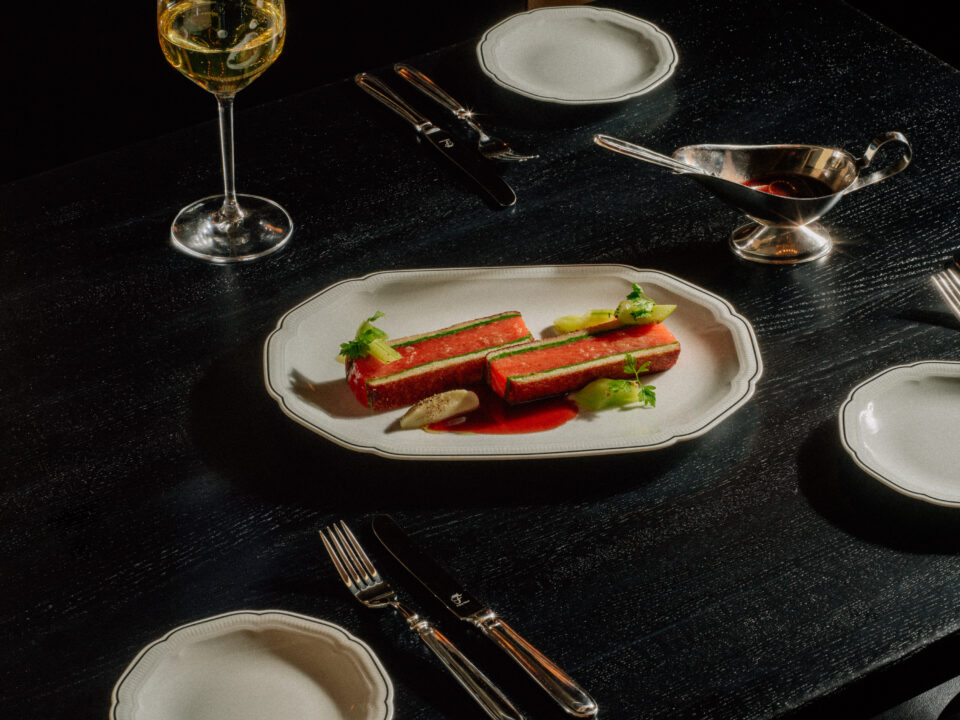
Photo: Nick Johnson
Meals at Koloman unfold with verve. Duck liver parfait has the silky interior of an egg-yolk. Spices in the celery root tartare are symphonic; mustard sparkling over mellower notes of parmesan and tarragon. Golden-crusted schnitzel paired with tart lingonberries and bright cucumber is the mouthful equivalent of the sun dropping into the Danube. I saved the beef and duck for another time, but watched them sail by and marveled over by fellow diners, with a gallerist’s admiration. The deserts, from Emiko Chisholm (formerly of Balthazar), are exceptional, each one oozing old-world charm made over. Butternut squash cheesecake with burnt sage streusel, anyone? The most endearing thing about my visit to Koloman, is that a server set their version of a white negroni on my coaster and proceeded to spritz essence of gentian over it from a crystal atomizer, all without an air of formality, only the ebullience of a good time in the making. So unexpectedly and delightfully camp, I had to have another.
El Quijote in the Hotel Chelsea, is something altogether different, a city stalwart that first opened its doors almost a century ago. After closing during hotel renovations in 2018, it re-opened in the Spring of 2022, with the same neon-red sign, new management and the reawakened tawdry splendor of a place where Hendrix and Joplin once sat before pitchers of Sangria. While smaller now, El Quijote has not had the transformation that nostalgists feared, only a proper facelift. Red vinyl booths have been reupholstered, the linoleum flooring peeled back to reveal gorgeous tilework, and the dramatic Don Quixote wall mural brightened to glory. As tapas arrive, heady with the aroma of garlic and shrimp tails, this enhanced El Quijote imparts the feeling of being wrapped inside of a bullfighter’s cape.
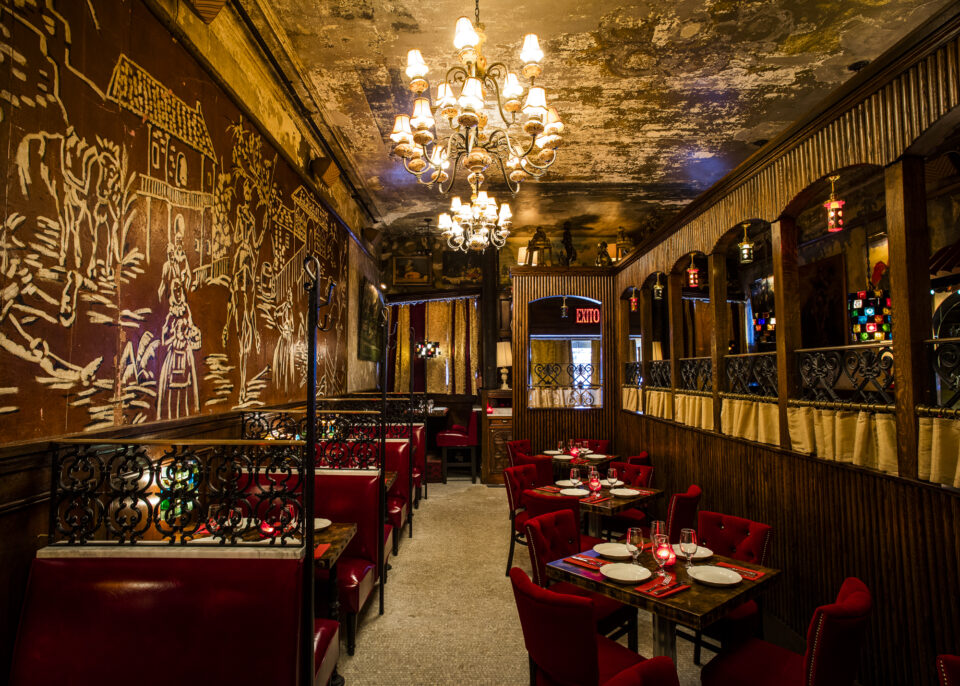
Photo: Eric Medsker
Jaime Young of Sunday Hospitality oversees an updated and carefully developed El Quijote menu. The old menu has been refreshed with a focus on Northern Spain where the Catalan, Basque and Galician regions have distinct culture, language and foodways and are home to a large portion of Spain’s indigenous communities. Classic tapas – croquetas, patatas, gambas – all shimmer with an extra layer of piquancy. Blood sausage in squid Ink takes something hearty and makes it even richer. Even a simple dish like pan con tomate is invitingly pungent. El Quijote is wonderful for large yet intimate gatherings and the arroz meloso de mariscos, a seafood rice dish, saturated with flavour, begs to be shared along with a pitcher of spice-infused, pineapple or peach laden sangria.
If New York is a melting pot, its hotel dining, in spite of these entrants, is still a way from reflecting global cuisines more fully. The stalwart New American menu, Paris-inspired brasserie, elegant Italian, modern bistro and ‘classic’ (as defined by whom? – we might ask) Mediterranean, remain where some of the most sought-after hotels tend to place their bets. Locanda Verde in the Greenwich Hotel, Le Coucou in 11 Howard, Ai Fiori in The Langham, Majorelle in The Lowell, The Mark Restaurant in The Mark Hotel and Le Crocodile in The Wythe are part of a long list of restaurants that, albeit first-rate, fall in those categories. And there is no shortage of splashy new additions from exceptional chefs. More recently they include Pierre Gagnaire’s Fouquet’s in the Hotel Barrière Fouquet’s New York, whose Champs Elysees namesake is the archetype of Parisian brasseries, and Ignacio Mattos’ modern bistro, Corner Bar in Nine Orchard, possibly the most talked about hotel opening of 2022. Uruguayan-born Mattos, lauded for his ability to pare and blend Italian, Spanish and Middle Eastern flavours, a skill that has earned him a deserved reputation as one of the city’s most talented chefs, is set to open Amado Grill in the same location later this year. I will be trying to crash Resy to make a booking, but my hope is new openings continue to represent more global diversity.
To contemplate if that’s on the horizon, it’s worth considering why hotel dining became such a big trend at all and why it matters. The boutique hotel boom in New York, going back to Schrager’s entry, planted the seeds of symbiotic relationships with influential chefs. At a time when hotel pioneers of the past, figures like J.W. Mariott and Conrad Hilton, had become synonymous with reliable carpeted dining rooms and cookie-cutter comfort, boutique hotels offered a stay that was part of the adventure and experience of travel. Courting influential chefs became a path to instant recognition; food and beverage became no longer simply a service, but a currency. For chefs and restaurateurs, a deal that can fund everything, from rent, to interior design, to the actual kitchen sink, can be a no-brainer especially in a city where real estate alone will eat your lunch. Hotels in New York became integral to the rising trajectory of chefs at the aforementioned eateries, and many others such as Mario Carbone and Rich Torrisi, Daniel Humm and Tom Colicchio.
Luxe hotel dining is not the ideal solution to the impossibility of sky-rocketing rent and creeping payroll that, now more than ever, makes opening a restaurant prohibitive for independent operators; gentrification has already swallowed too much of the city’s charm and there is a twisted irony in debating equity in cuisines offered when food workers still struggle to make a living wage. But in a city where hotels do give chefs a way to realize their grander visions, it is worth asking which chefs and encouraging resources away from the current literal and figurative true North of fine dining, so that what might be a passing fancy for other cuisines (the Global South and East especially), becomes a structural shift. And while fancy restaurants at hotels and deep-pocketed institutions are only accessible to the few who can afford meals out and travel, they do matter because they define what is aspirational, which in turn defines where capital and attentions flows.
A major reason hotels cite for the persistent focus on Eurocentric cuisines is that their kitchens need to provide all-day meals and basic room service. But perhaps what the industry needs is to normalize a breakfast of tamagoyaki, a soup-dumpling lunch, chicken stew and fufu after a long day, and a midnight samosa snack. The entrenchment of some foodways is not so different from the Hollywood myth that only a White male lead can capture a wide audience, a myth that was blown apart when the box office embraced Chadwick Boseman in Black Panther or most recently Michelle Yeoh, who became the first Asian woman to win a best actress Oscar earlier this year for her role in indie smash hit Everything Everywhere All At Once.
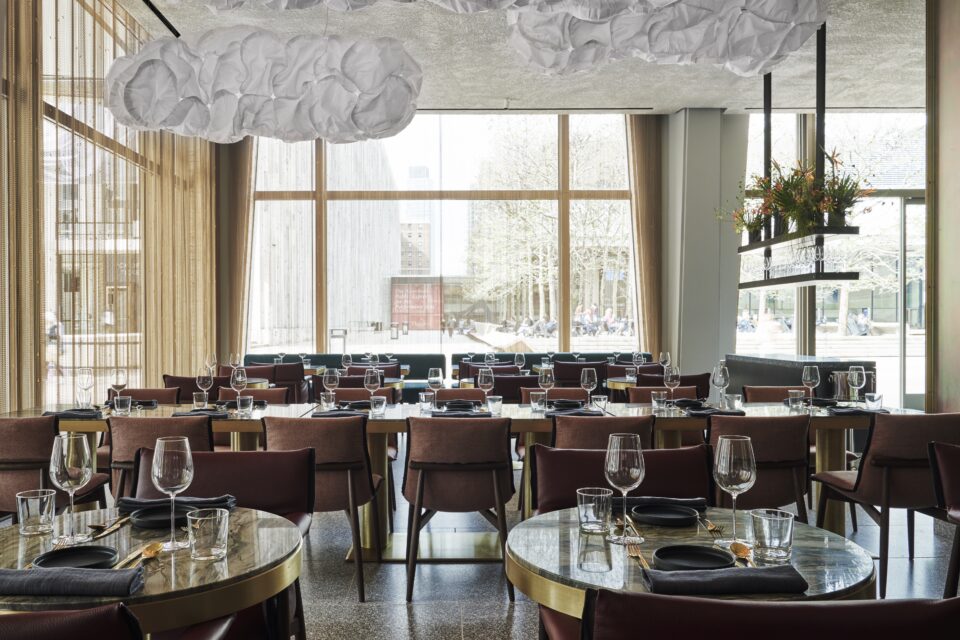
Photo: Adrian Gaut/Courtesy of Lincoln Center and Modellus Novus
Indeed, hoteliers and developers need look no further than the arts for proof that big bets on under-served cuisines are viable, valuable and vital. Just months ago, in November of 2022, David Geffen Hall, home to the New York Philharmonic, reopened at Lincoln Center (site also of the Met Opera, New York City Ballet and Lincoln Center Film) after a $550 million renovation, years in the making. Geffen Hall houses the oldest symphony orchestra in the US and a predictably aging audience. Its architects, in the broadest sense, understood the importance of moving with the times and forging ties with a broader demographic. Improved acoustics inside the hall aside, the building has two major new features of note; garage door style openings that welcome audiences in to a discipline – classical music, that has historically kept people out, and a spanking new restaurant from thirty-three-year-old Nigerian-American chef, author, former Top Chef contestant and James Beard Rising Star, Kwame Onwuachi. Good luck getting a reservation: even diners coming in pre or post show have declared that the Afro-Caribbean jam to New York that Tatiana serves up, is truly the main event.
It is fitting that Bronx-born Onwuachi has crafted a whole mood into a corner of the city that has been known more for its sedate patrons than its street style by inflecting Lincoln Center with the ‘90s music and energy of his youth and by drawing on his roots; West Africa via Nigeria on his father’s side and creole-influenced US Gulf Coast on his mother’s. It is a reverent sort of homecoming when you consider that Lincoln Center stands on land that was once San Juan Hill, a vibrant Black and Puerto Rican neighborhood that was razed in the 1950s to make way for the center’s opulent buildings. The kinetic energy of Tatiana’s graphite walls, industrial beams, cloud-like pendant lights, open kitchen, and black crockery splashed with dishes so artful and vibrant they feel like a Kehinde Wiley on a plate, harness the past to harken to the future in a way that only seems possible when you dare to step out of your lane, or, in Onwuachi’s case, claim the whole highway.
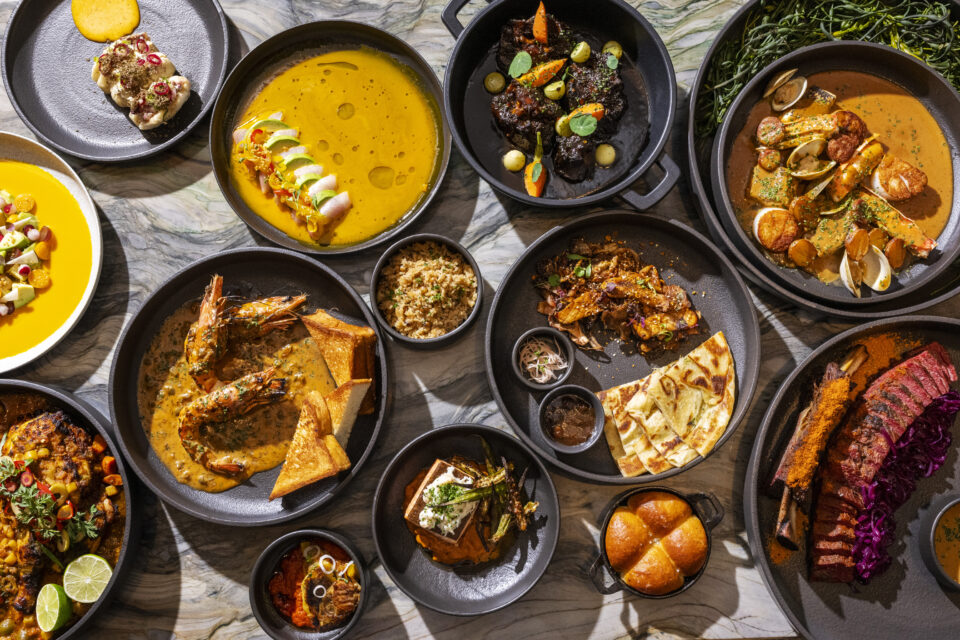
Photo: Evan Sung
The food at Tatiana holds its own on every front – exceptional and surprising, exciting and comforting. After messing my fingers on crispy okra dripping in a honey mustard peppa sauce, I tucked into curried goat patties with green aioli and mango chutney. Delicate scallops, arranged as precisely as bowling pins held up remarkably under a jerk spice, and a red snapper, crisped to perfection in brown stew, paired blistering crunch with seductive flakiness. I opted for seafood over the much-touted short rib pastrami suya because I was already plotting a return to savour Onwuachi’s take on Jewish Deli meets Nigerian street food, both a capsule of his New York and a collaborative dish which pairs executive sous-chef Nikki Dembeck’s caraway cocoa bread with chef de cuisine Kamat Newman’s mustard jus. The cocktail program from beverage industry veteran Don Lee is as robust as the menu. I’m partial to the LC Negroni which spices up the classic with Caribbean Sorrel and a tawny East India Sherry. The ‘bodega special’ dessert – brownie with a side of donut ice cream, is a genius parting shot, hinting, via evocations of traybakes and childhood hankerings, that culinary snobbery has no place in the ingredients of good food.
Those holding the keys ought to take note; Tatiana’s advocates appear to have tossed the worn playbook for restaurant-as-draw, and acted with intention to signal dispensing with the old guard of upscale dining. Onwuachi and his team have rewarded them with a runaway success that puts the fine in dining. Named for Onwuachi’s sister, who brought him up while their mother worked as a chef, Tatiana has all the heart of that story and menu, mood and staff that makes you want to linger as if at a great dinner party. Isn’t that everything dining-out could hope for? Indeed, Tatiana is a question that has answered itself, occupying a glass corner enface the curve of Lincoln Center’s iconic fountain. If Lincoln Center, with its rarified air of prestige, can reframe the story of whose food is elevated or mainstreamed, I hope more landlords and hoteliers feel similarly encouraged, so the axis of fine dining truly shifts. Inside Tatiana, a beaded metal curtain skirting floor-to-ceiling glass walls was crafted to call back to chain link fences around public playgrounds. When I looked between its chinks towards the grand buildings of the opera and the ballet, the swishing silver beads seemed to murmur that the world of upscale dining has long been overdue for a feeling of true welcome, that velvet ropes have always been passé.
Soleil Nathwani is a New York-based Culture Writer and Film Critic. A former Film Executive and Hedge Fund COO, Soleil hails from London and Mumbai. Twitter: @soleilnathwani



